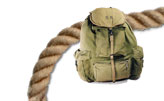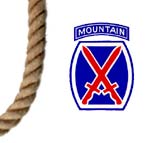| The Rucksack story... |
|
A mountain soldier could not fit all of his gear into the M-1928
haversack, the Army’s standard backpack at the beginning of
World War II. Even if he could, the haversack carried the
weight high on his back and it shifted side to side, throwing him
off balance while skiing or climbing. Thus, the Army needed
something more practical for their new mountain soldiers. |
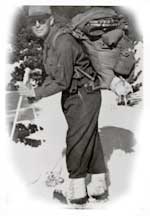 |
U.S. Army Specification File No. 2971,
July 7, 1941 |
| U.S. Army developed and adopted its first rucksack
during the summer of 1941. The canvas duck sack was mounted
on a steel wire or rattan frame that supported the load and held it
off the soldier's back. Three pockets on the outside of the
bag carried extra gear. Heavy felt pads on both the back support
and the shoulder straps eased the burden. Brass snap hooks closed
the two side pockets and the cover flap. The 1941 pattern rucksacks
were made during late 1941 and into early 1942. Most rucksacks
are stamped “1941,” although some made by Powers Company
can be found stamped "1942." |
Being based on a typical commercial rucksack, this
first army rucksack was poorly suited for military use. The
National Ski Association's Winter Equipment Committee reviewed the
rucksack at the War Department's request and suggested twelve improvements
that the QMC then incorporated into the next generation rucksack.
With the adoption of the Specification J.Q.D. 88 rucksack, the Army
withdrew the 1941 pattern from service. Because the two patterns
never overlapped within the supply system, they were never known as
the M-1941 or M-1942 version. Its official name was always just
"Rucksack." |
| |
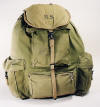 |
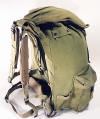 |
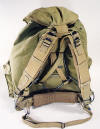 |
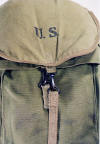 |
|
| |
1941
pattern rucksack rear view. |
Side
view. Note the heavy felt shoulder pads. |
Front view showing wire frame, shoulder pads, and belly-band.
|
Details
of the main flap closure snap. |
|
Quartermaster Tentative Specification J.Q.D. 88, March
14, 1942
| National Ski Association's Winter
Equipment Committee’s twelve suggestions created a rucksack
better suited for military use. Tentative Specification J.Q.D.
88 rucksacks had a leather frame support that bore heavy loads better
than the 1941 pattern’s web frame support pocket. Attaching
the shoulder straps directly to the frame support held the rucksack
more tightly to the soldier’s shoulders and let him carry the
rucksack without a frame if needed. Two wide, web straps with
double-bar, bronze buckles encircled the rucksack pouch and pouch
flap on both sides of the meat can pocket. The straps reinforced
the pouch, kept the cover flap tightly closed to keep out snow, and
squeezed the load close to the frame. A separate belly-band,
worn higher than on the previous version, passed through slots made
by the reinforcement straps. Four canvas equipment tabs, two
on each side of the rucksack, provided attachments for equipment such
as the intrenching tool, bayonet, and first aid pouch. The rucksacks
continued to use the heavy ribbed web shoulder straps and thick felt
pads found on the 1941 pattern rucksacks. |
A new metal frame, made of
½-inch tubular steel, replaced the wire or rattan frame used
with the 1941 rucksack. The frame had a more pronounced “U”
shape with “horns” that came around the soldier’s
hip. Three steel tubing pieces welded to the center of the frame
formed a triangle for reinforcement. Being much sturdier than
was necessary to support even the soldier’s heaviest loads,
the tubular frame was specifically designed to form the body of an
emergency sled by joining two rucksack fames and two pair of skis
using
ski adaptors and contraction bands. Specification J.Q.D. 88 rucksacks
are extremely rare today. I have not seen one in twenty years
of collecting mountain troop gear. Most likely few were made,
as an improved version appeared only five months later. If anyone
has a J.Q.D. 88 rucksack available to purchase or to photograph, please
contact me.
|
| |

These two images, taken from an early 1942 ski training film, show
a J.Q.D 88 rucksack. |
|

Note
the ribbed shoulder straps, felt pads, and equipment tabs on the right
side. |
|
Quartermaster Tentative Specification J.Q.D. 88B, August
26, 1942
| Jeffersonvile
Quartermaster Depot continued to refine the rucksack’s features
in Tentative Specification J.Q.D. 88B. Regular canvas webbing
replaced the ribbed webbing shoulder straps, the felt shoulder pads
were eliminated, and the number of equipment attachment tabs decreased
from four to three, all sewn along the upper left side of the pouch.
Most significantly, J.Q.D. 88B added a rifle securing strap, a wire
rifle snap hook on the right horn of rucksack frame,
|
and a small hook on the
left shoulder strap. These additions made it easier for the
soldier to carry his rifle while using a rucksack.
Click here to see how to use the rifle strap.
| Assembling and Using the Rifle Strap |
| This drawing, taken from the Mountain Training
Center's 1942 Proposed Manual For Mountain Troops shows the how
the rifle strap was assembled and wrapped around the rifle. |
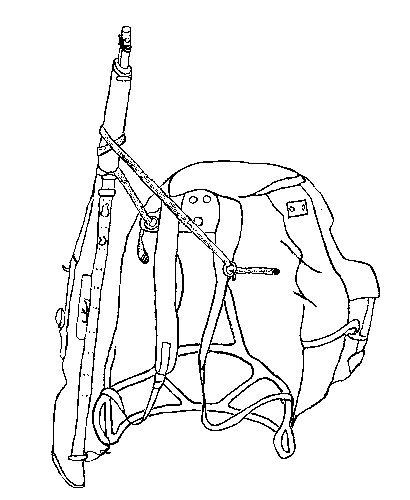
Training Manual TM 10-275, Principles
of Cold Weather Clothing and Equipment, 26 October 1944, offered
the following directions on how to attach the rifle to the rucksack:
a) Hold the rifle at the balance point with the left hand, with sling down.
b) Snap the wire hook, which is on the right horn of the pack frame, into
the butt swivel on the side toward the body. Hold the piece erect from
the swivel.
c) Bring the strap from the right top of the rucksack forward over the
right shoulder, passing outside the piece.
d) Grasp the strap with the left hand and snap it over the head, allowing
the rifle to drop between the pack and the right should, with the sling
to the body. Place the ring on the strap into the hook on the left shoulder
strap. The ring will slide in and out of the hook most easily if it is
turned half over and rolled in or out. The rifle is released by rolling
the ring out of the hook, putting the strap over the head, and letting
the piece slide down the strap into the hand. The hook is then unsnapped
from the butt swivel.” |
The J.Q.D. 88B rucksack was the primary rucksack used by the mountain
soldiers during World War II. It was produced in large quantities
and is the rucksack most commonly seen by collectors today |
| |
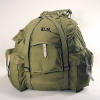
J.Q.D. 88B rucksack rear view. The large center pocket was for
the meat can. |
|
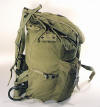
Side
view. Note the three equipment tabs on the left side.
|
|
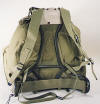
Front
view showing the frame and belly-band. |
|
| |
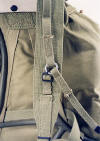
Rifle strap attached to the shoulder strap hook. |
|
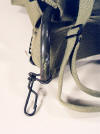
The
wire rifle snap attached to the rucksack frame horn. |
|
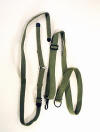
Rifle strap (left) and belly-band (right). The rifle strap is
41 inches long. |
|
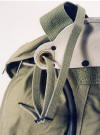
The
rifle strap attached through the large grommet in the leather frame
pocket. |
|
Quartermaster Tentative Specification J.Q.D. 88F, August 1943
| Specification J.Q.D. 88F
changed the first eighteen inches of the pouch reinforcement straps
from web to leather and changed the pouch reinforcement straps' double-bar
buckles to tongue and roller buckles. These changes made the
rucksack easier to open when the straps were frozen or while wearing
mittens. |
These rucksacks used the darker OD shade 7 canvas adopted
in July 1943 by the QMC for all web equipment. The dark color
and long leather straps make it easy for collectors to spot the J.Q.D.
88F rucksack. Because they were made late in the rucksack's
development and at a time when many J.Q.D. 88B rucksacks were already
available, few, if any, J.Q.D. 88F rucksacks would have been used
at Camp Hale. Collectors rarely see them today. |
| |
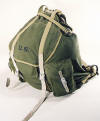
J.Q.D. 88F rucksack rear view showing the OD shade 7 canvas and leather
closure straps. |
|
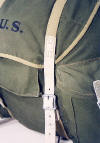
Details
of the leather strap and roller buckle. |
|
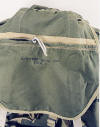
Interior
view showing the maker information and map pocket zipper. |
|
| Many companies
produced rucksacks during World War II. Those that I have identified
and the years that they manufactured rucksacks are listed in the
table to the right. Once the companies completed their 1943 contracts,
it appears that the QMC purchased no more rucksacks until 1951.
If you have a rucksack made by a company not listed on this table
or that was made between 1944 and 1950, please let me know. |
|
Year
and Pattern Type |
| Company |
1941 |
1942 |
1943 |
1944 |
1945 |
| American
Fabrics Co |
- |
88B |
88F |
- |
- |
| Atlantic
Products Corp |
- |
88B |
- |
- |
- |
| Avery
Mfg. Co |
- |
88B |
88B,88F |
- |
- |
Baker-Lockwood
Mfg. Co. |
1941 |
88B |
88B |
- |
- |
| Hinson
Mfg. Co. |
- |
88B |
88B,88F |
- |
- |
| Lichtenberger-Ferguson
Co. |
- |
- |
88B |
- |
- |
| Lyon
Coulson Inc. |
- |
88B |
- |
- |
- |
| Meese
Inc. |
1941 |
88B |
88B |
- |
- |
| Morrow
& Douglass |
- |
88B |
88B |
- |
- |
| Powers
Co. |
1941 |
1941 |
- |
- |
- |
| Protections
Products Co. |
- |
88B |
88F |
- |
- |
| Simmons
Company |
- |
88B |
- |
- |
- |
Varied
Mfg.
Co. Inc. |
- |
88B |
88B |
- |
- |
| Werner
Siegmund Inc. |
- |
88B |
88B |
- |
- |
|
|
|
|
|
